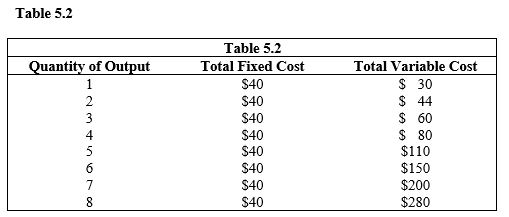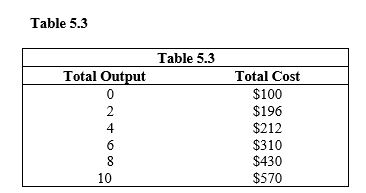A) $35
B) $245
C) $3
D) $38
E) $17
Correct Answer

verified
Correct Answer
verified
Multiple Choice
 -Refer to Table 5.2. We can conclude that the marginal-cost curve intersects the average-variable-cost curve at ____ units of output and the average-total-cost curve at ____ units of output.
-Refer to Table 5.2. We can conclude that the marginal-cost curve intersects the average-variable-cost curve at ____ units of output and the average-total-cost curve at ____ units of output.
A) 1; 1
B) 2; 3
C) 4; 4
D) 4; 5
E) 6; 7
Correct Answer

verified
Correct Answer
verified
Multiple Choice
The short run is a
A) 5K run.
B) period of time when plant size cannot be changed.
C) period of time when all resources are variable.
D) period of time when average total costs decline.
E) maximum of 90 days.
Correct Answer

verified
Correct Answer
verified
Multiple Choice
 -Refer to Table 5.3. Assuming that costs are equally distributed for the odd output integers, the marginal cost of the sixth unit is
-Refer to Table 5.3. Assuming that costs are equally distributed for the odd output integers, the marginal cost of the sixth unit is
A) $49.
B) $98.
C) $310.
D) $80.
E) $261.
Correct Answer

verified
Correct Answer
verified
True/False
If the marginal cost is lower than the average cost, the average cost is falling.
Correct Answer

verified
Correct Answer
verified
Multiple Choice
A profit-maximizing firm will produce the level of output such that
A) average revenue equals average cost.
B) average revenue equals variable cost.
C) marginal revenue equals rising marginal cost.
D) marginal cost equals rising marginal revenue.
E) marginal revenue exceeds marginal cost by the maximum amount.
Correct Answer

verified
Correct Answer
verified
Multiple Choice
Economic profit is
A) part of total cost.
B) total revenue minus all opportunity costs.
C) total revenue minus accounting costs.
D) the opportunity cost of doing business.
E) total variable cost minus total fixed cost.
Correct Answer

verified
Correct Answer
verified
True/False
Assume that a firm is producing an output level such that marginal revenue equals marginal cost. One can correctly conclude that the firm is earning a normal profit.
Correct Answer

verified
Correct Answer
verified
Multiple Choice
In the long run,
A) all of a firm's resources are variable.
B) new technology cannot be introduced.
C) at least one of the firm's resources is fixed.
D) most of the firm's resources cannot be varied.
E) none of the firm's resources is variable.
Correct Answer

verified
Correct Answer
verified
True/False
The marginal cost and average cost curves always intersect at the minimum average cost.
Correct Answer

verified
Correct Answer
verified
Multiple Choice
Diminishing marginal returns occur because
A) average and marginal relationships behave very differently with respect to each other.
B) the efficiency of variable resources depends on the quantity of the fixed resources.
C) producers are not careful enough in the manufacturing process.
D) workers are lazy and inefficient.
E) workers in some industries lack an adequate formal education.
Correct Answer

verified
Correct Answer
verified
Multiple Choice
The existence of economic profits in a competitive market
A) will attract competitors.
B) is usually against the law.
C) allows firms to create monopolies.
D) results in normality.
E) increases negative economic net worth.
Correct Answer

verified
Correct Answer
verified
Multiple Choice
Assume that marginal revenue equals rising marginal cost at 100 units of output. At this output level, a profit-maximizing firm's total fixed cost is $600 and its total variable cost is $400. If the price of the product is $8 per unit, the firm should produce
A) zero units of output.
B) less than 100 units of output.
C) 100 units of output.
D) more than 100 units of output.
E) The amount is impossible to determine from the information given.
Correct Answer

verified
Correct Answer
verified
Multiple Choice
Economic profit is the difference between a firm's total revenue and its
A) average costs.
B) mandatory costs.
C) opportunity costs not measured in explicit costs.
D) accounting costs.
E) opportunity costs.
Correct Answer

verified
Correct Answer
verified
Multiple Choice
Which of the following sayings illustrates diminishing returns in the short run?
A) Too many cooks spoil the broth.
B) Jack be nimble, Jack be quick.
C) When the cat is away, the mouse will play.
D) A rolling stone gathers no moss.
E) The grass is always greener on the other side of the fence.
Correct Answer

verified
Correct Answer
verified
Multiple Choice
When a firm's marginal revenue exceeds its marginal cost, it is producing
A) too much, and should cut back on production to maximize profit/minimize losses.
B) too little, and should increase production to maximize profit/minimize losses.
C) the right amount, as revenue exceeds cost.
D) too much and its machines and employees are overworked.
E) Not enough information is provided to determine what the firm should do.
Correct Answer

verified
Correct Answer
verified
Multiple Choice
Which of the following is not a variable cost at the sandwich shop?
A) Cost of tomatoes
B) Cost of labor
C) Cost of rent
D) Cost of electricity
E) Cost of bread
Correct Answer

verified
Correct Answer
verified
True/False
Economic profit is the difference between a firm's total revenue and its accounting costs.
Correct Answer

verified
Correct Answer
verified
Multiple Choice
If the marginal costs exceed marginal revenue, the firm
A) is maximizing profit.
B) should reduce its level of output to increase profit.
C) would increase profits by increasing production.
D) should shut down.
E) is minimizing its loss.
Correct Answer

verified
Correct Answer
verified
Multiple Choice
The additional cost a firm incurs from selling an extra unit of output is
A) total cost.
B) marginal cost.
C) average cost.
D) fixed cost.
E) variable cost.
Correct Answer

verified
Correct Answer
verified
Showing 21 - 40 of 119
Related Exams